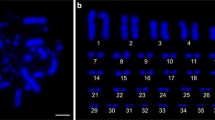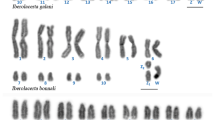Abstract
The iguanid lizard Sceloporus grammicus has a high level of karyotypic variability, and has often been cited as an example of chromosomal speciation. We examined a total of 2036 secondary spermatocytes from 30 S. grammicus males, and found that 16 of the 30 individuals (including a single lizard collected from a hybrid zone between two chromosome races) produced completely balanced spermatocytes. Fourteen of the 30 lizards (including both chromosomal heterozygotes and homozygotes) had relatively low (0.6% to 7.1%) levels of aneuploidy. Heterozygotes had a 1.1% increase over homozygotes in the number of aneuploid spermatocytes observed. The frequency of aneuploidy in S. grammicus may not be high enough to cause chromosomal speciation by any of the mechanisms that have been proposed for this complex. Most individuals showed balanced segregation of the autosomal trivalents, but nearly half of the lizards had a significant excess of spermatocytes with the X1 and X2 rather than the Y sex chromosomes. Five lizards had spermatocytes which had fission mutations not found in the somatic cells. As many as 5.9% of the spermatocytes in one individual had chromosomal mutations. This chromosomal mutation rate has important implications for chromosomal evolution in S. grammicus.
Similar content being viewed by others
References
BakerR. J., 1981. Chromosome flow between chromosomally characterized taxa of a volant mammal, Uroderma bilobatum (Chiroptera: Phyllostomatidae). Evolution 35: 296–305.
BakerR. J. & BickhamJ. W., 1986. Speciation by monobrachial centric fusions. Proc. Natl. Acad. Sci. USA. 83: 8245–8248.
BakerR. J., QumsiyehM. B. & HoodC. S., 1987. Role of chromosomal banding patterns in understanding mammalian evolution. In: Current Mammalogy, Vol. 1 (ed. H. H.Genoways). pp. 67–96. Plenum Publ. Co., New York.
BaranovV. S., 1980. Mice with Robertsonian translocations in experimental biology and medicine. Genetica 52/53: 23–32.
BartonN. & BengtssonB. O., 1986. The barrier to genetic exchange between hybridising populations. Heredity 56: 357–376.
BartonN. H. & HewittG. M., 1981. Hybrid zones and speciation. In: Evolution and Speciation. Essays in honor of M. J. D. White (eds. W. R.Atchley and D. S.Woodruff), pp. 109–145. Cambridge Univ. Press, Cambridge.
BengtssonB. O., 1985. The flow of genes through a genetic barrier. In: Evolution: Essays in honour of John Maynard Smith (eds. P. J.Greenwood, P. H.Harvey, and M.Slatkin), pp. 31–42. Cambridge Univ. Press, Cambridge.
BruèreA. N., 1974. The segregation patterns and fertility of sheep heterozygous and homozygous for three different Robertsonian translocations. J. Reprod. Fert. 41: 453–464.
BruèreA. N. & ChapmanH. M., 1974. Double translocation heterozygosity and normal fertility in domestic sheep. Cytogenet. Cell Genet. 13: 342–351.
BruèreA. N., ScottI. S. & HendersonL. M., 1981. Aneuploid spermatocyte frequency in domestic sheep heterozygous for three Robertsonian translocations. J. Reprod. Fert. 63: 61–66.
CapannaE., 1982. Robertsonian numerical variation in animal speciations: Mus musculus, an emblematic model. In: Mechanisms of Speciation (ed. C.Barigozzi), pp. 155–177, A. R. Liss, New York.
CapannaE., GroppA., WinkingH., NoackG. & CivitelliM.-V., 1976. Robertsonian metacentrics in the mouse. Chromosoma 58: 341–353.
CattanachB. M. & MoseleyH., 1973. Nondisjunction and reduced fertility caused by the tobacco mouse metacentric chromosomes. Cytogenet. Cell Genet. 12: 264–287.
ChapmanH. M. & BruèreA. N., 1975. The frequency of aneuploidy in the secondary spermatocytes of normal and Robertsonian translocation-carrying rams. J. Reprod. Fert. 45: 333–342.
ColeC. J., 1977. Chromosomal aberration and chromatid exchange in the North American fence lizard, Sceloporus undulatus (Reptilia: Iguanidae). Copeia 1977: 53–59.
ColeC. J., LoweC. H. & WrightJ. W., 1967. Sex chromosomes in lizards. Science 155: 1028–1029.
CurtsingerJ. W., 1984. Components of selection in X chromosome lines of Drosophila melanogaster: Sex ratio modification by meiotic drive and viability selection. Genetics 108: 941–952.
DöringL., GroppA. & TettenbornU., 1972. DNA content and morphological properties of presumably aneuploid spermatozoa of tobacco mouse hybrids. J. Reprod. Fert. 30: 335–346.
FordC. E. & EvansE. P., 1973. Robertsonian translocations in mice: Segregational irregulaties in male heterozygotes and zygotic unbalance. Chromosomes Today 4: 387–397.
FutuymaD. J. & MayerG. C., 1980. Non-allopatric speciation in animals. Syst. Zool. 29: 254–271.
GinzburgL. R., BinghamR. M. & YooS., 1985. On the theory of speciation induced by transposable elements. Genetics 107: 331–341.
GroppA. & WinkingH., 1981. Robertsonian Translocations: Cytology, meiosis, segregation patterns and biological consequences of heterozygosity. Symp. Zool. Soc. Lond. 47: 141–181.
GroppA., WinkingH. & RediC., 1982. Consequences of Robertsonian heterozygosity: Segregational impairment of fertility versus male-limited sterility. In: The Genetic Control of Gamete Production and Function (eds P. G.Crosignani & S.Rubin), pp. 115–134. Academic Press, New York.
GroppA., WinkingH., ZechL. & MüllerH., 1972. Robertsonian chromosomal variation and identification of metacentric chromosomes in feral mice. Chromosoma 39: 265–288.
HägeleK., 1984. Different hybrid effects in reciprocal crosses between Chironomus thummi thummi and Ch. th. piger including spontaneous chromosomal aberrations and sterility. Genetica 63: 105–111.
Hall, W. P., 1973. Comparative population cytogenetics, speciation, and evolution of the iguanid lizard genus Sceloporus. Ph.D. thesis, Harvard Univ. Cambridge, Massachusetts.
HallW. P., 1980. Chromosomes, speciation and evolution of Mexican iguanid lizards. Natl. Geogr. Soc. Res. Repts. 12: 309–329.
HallW. P., 1983. Modes of speciation and evolution in the sceloporine iguanid lizards. I. Epistemology of the comparative approach and introduction to the problem. In: Advances in Herpetology and Evolutionary Biology (eds. A. E.Rhodin & K.Miyata), pp. 643–679. Museum of Comparative Zoology, Cambridge, Massachusetts.
HallW. P. & SelanderR. K., 1973. Hybridization of karyotypically differentiated populations in the Sceloporus grammicus complex (Iguanidae). Evolution 27: 226–224.
HedrickP. W., 1981. The establishment of chromosomal variants. Evolution 35: 322–332.
JohnB., 1981. Chromosome change and evolutionary change: a critique. In: Evolution and Speciation. Essays in honor of M. J. D. White (eds. W. R.Atchley and D. S.Woodruff), pp. 262–285. Cambridge Univ. Press, Cambridge.
JohnB. & FreemanM., 1975. Causes and consequences of Robertsonian exchange. Chromosoma 52: 123–136.
KimuraM., 1983. The Neutral Theory of Molecular Evolution. Cambridge Univ. Press, London.
LandeR., 1979. Effective deme sizes during long-term evolution estimated from rates of chromosomal rearrangement. Evolution 33: 234–251.
LandeR., 1985. The fixation of chromosomal rearrangements in a subdivided population with local extinction and colonization. Heredity 54: 323–332.
Lara-GongoraG., 1983. Two new species of the lizard genus Sceloporus (Reptilia, Sauria, Iguanidae) from the Ajusco and Ocuilan Sierras, Mexico. Bull. Maryland Herpetol. Soc. 19: 1–14.
LogueD. N. & HarveyM. J. A., 1978. Meiosis and spermatogenesis in bulls heterozygous for a presumptive 1/29 Robertsonian translocation. J. Reprod. Fert. 54: 159–165.
LongS. E., 1978. Chiasma counts and non-disjunction frequencies in a normal ram and in rams carrying the Massey I (t1) Robertsonian translocation. J. Reprod. Fert. 53: 353–356.
McBeeK., BickhamJ. W. & DixonJ. R., 1987. Male heterogamety and chromosomal variation in Carribean geckos. J. Herpetol. 21: 68–71.
McKeeB., 1984. Sex chromosome meiotic drive in Drosophila melanogaster males. Genetics 106: 403–422.
MøllerO. M., NesN. N., SyedM., FougnerJ. A., NorheimK., & SmithA. J., 1985. Chromosomal polymorphism in the blue fox (Alopex lagopus) and its effects on fertility. Hereditas 102: 159–164.
MoritzC., 1986. The population biology of Gehyra (Gekkonidae): Chromosome change and speciation. Syst. Zool. 35: 46–67.
NaveriaH. & FontdevilaA., 1985. The evolutionary history of Drosophila buzzatii. IX. High frequencies of new chromosome rearrangements induced by introgressive hybridization. Chromosoma 91: 87–94.
PaullD., WilliamsE. E. & HallW. P., 1976. Lizard karyotypes from the Galapagos islands: Chromosomes in phylogeny and evolution. Breviora 441: 1–31.
PetersG. B., 1982. The recurrence of chromosome fusion in interpopulation hybrids of the grasshopper Atractomorpha similis. Chromosoma 85: 323–347.
Porter, C. A., 1987. Triploidy in the lizard Sceloporus grammicus. J. Herpetol. (in press).
PorterC. A. & SitesJ. W.Jr., 1985. Normal disjunction in Roberstonian heterozygotes from a highly polymorphic lizard population. Cytogenet. Cell Genet. 39: 250–257.
PorterC. A. & SitesJ. W.Jr., 1986. Evolution of Sceloporus grammicus complex (Sauria: Iguanidae) in central Mexico: Population cytogenetics. Syst. Zool. 35: 334–358.
ProutT., 1986. Hardy-Weinberg and fertility selection. Evolution 40: 1357.
SearleJ. B., 1984a. Hybridization between Robertsonian karyotyic races of the common shrew Sorex araneus. Experientia 40: 876–878.
SearleJ. B., 1984b. Nondisjunction frequencies in Robertsonian heterozygotes from natural populations of the common shrew, Sorex araneus L. Cytogenet. Cell Genet. 38: 265–271.
SearleJ. B., 1986. Meiotic studies of Robertsonian heterozygotes from natural populations of the common shrew, Sorex araneus L. Cytogenet. Cell Genet. 41: 154–162.
ShawD. D., WilkinsonP. & CoatesD. J., 1983. Increased chromosomal mutation rate after hybridization between two subspecies of grasshoppers. Science 220: 1165–1167.
SitesJ. W.Jr., 1982. Morphological variation within and among three chromosome races of Sceloporus grammicus (Sauria, Iguanidae) in the north-central part of its range. Copeia 1982: 920–941.
SitesJ. W.Jr., 1983. Chromosome evolution in the iguanid lizard Sceloporus grammicus. I. Chromosome polymorphisms. Evolution 37: 38–53.
Sites, J. W., Jr., Camarillo, J. L., Gonzalez, A., Mendoza, F., Javier, L., Mancilla, M. & Lara-Gongora, G., 1987c. Allozyme variation and genetic divergence within and between three cytotypes of the Sceloporus grammicus complex (Sauria, Iguanidae) in central Mexico. Herpetologica (in review).
SitesJ. W.Jr. & DixonJ. R., 1981. A new subspecies of the iguanid lizard, Sceloporus gramicus from northeastern Mexico, with comments on its evolutionary implications and the status of S. g. disparilis. J. Herpetol. 15: 59–69.
SitesJ. W.Jr. & GreenbaumI. F., 1983. Chromosome evolution in the iguanid lizard Sceloporus grammicus. II. Allozyme variation. Evolution 37: 54–65.
Sites, J. W., Jr. & Moritz, C., 1987. Chromosomal evolution and speciation revisited. Syst. Zool. (in press).
SitesJ. W.Jr., PorterC. A. & ThompsonP., 1987a. Genetic structure and chromosomal evolution in the Sceloporus grammicus complex. Natl. Geogr. Res. 3: 343–362.
Sites, J. W., Jr., Thompson, P. & Porter, C. A., 1987b. Cascading chromosomal speciation in lizards: a second look. Pacif. Sci. (in press).
SouthernD. I., 1969. Stable telocentric chromosomes produced following centric misdivision in Myrmeleotettix maculatus (Thumb.). Chromosoma 26: 140–147.
SpiritoF., RossiC. & RizzoniM., 1983. Reduction of gene flow due to the partial sterility of heterozygotes for a chromosome mutation. I. Studies on a ‘neutral’ gene not linked to the chromosome mutation in a two model population. Evolution 37: 785–797.
StollaR. & GroppA., 1974. Variation of the DNA content of morphologically normal and abnormal spermatozoa in mice susceptible to irregular meiotic segregation. J. Reprod. Fert. 38: 335–346.
TettenbornU. & GroppA., 1970. Meiotic nondisjunction in mice and mouse hybrids. Cytogenetics 9: 272–283.
ThompsonP. & SitesJ. W.Jr., 1986. Comparison of population structure in chromosomally polytypic and monotypic species of Sceloporus (Sauria: Iguanidae) in relation to chromosomally-mediated speciation. Evolution 40: 303–314.
WalshJ. B., 1982. Rate of accumulation of reproductive isolation by chromosome rearrangements. Amer. Natur. 120: 510–532.
WebsterT. P., HallW. P. & WilliamsE. E., 1972. Fission in the evolution of a lizard karyotype. Science 177: 611–613.
WhiteM. J. D., 1968. Models of speciation. Science 159: 1065–1070.
WhiteM. J. D., 1978a. Modes of Speciation, W. H. Freeman, San Francisco.
WhiteM. J. D., 1978b. Chain processes in chromosomal speciation. Syst. Zool. 27: 285–298.
WhitehouseD. B., EvansE. P., PuttW. & GeorgeA. M., 1984. Karyotypes of the East African common zebra, Equus burchelli: centric fission in a pedigree. Cytogenet. Cell Genet. 38: 171–175.
WiegmannA. F. A., 1828. Beytrage zur Amphibienkunde. Isis 21: 364–383.
WiegmannA. F. A., 1834. Herpetologia Mexicana. Pars prima, saurorum species amplectens. C. G. Lüderitz, Berlin.
WoodruffR. C. & ThompsonJ. N., 1980. Hybrid release of mutator activity and the genetic structure of natural populations. Evol. Biol. 12: 129–162.
WursterD. H. & BenirschkeK., 1968. Chromosome studies in the superfamily Bovoidia. Chromosoma 25: 152–171.
WursterD. H. & BenirschkeK., 1970. Indian Muntjac, Muntiacus muntjac: A deer with a low diploid chromosome number. Science 168: 1364–1366.
Author information
Authors and Affiliations
Rights and permissions
About this article
Cite this article
Porter, C.A., Sites, J.W. Evolution of Sceloporus grammicus complex (Sauria: Iguanidae) in central Mexico II. Studies on rates of nondisjunction and the occurrence of spontaneous chromosomal mutations. Genetica 75, 131–144 (1987). https://doi.org/10.1007/BF00055257
Received:
Accepted:
Issue Date:
DOI: https://doi.org/10.1007/BF00055257




